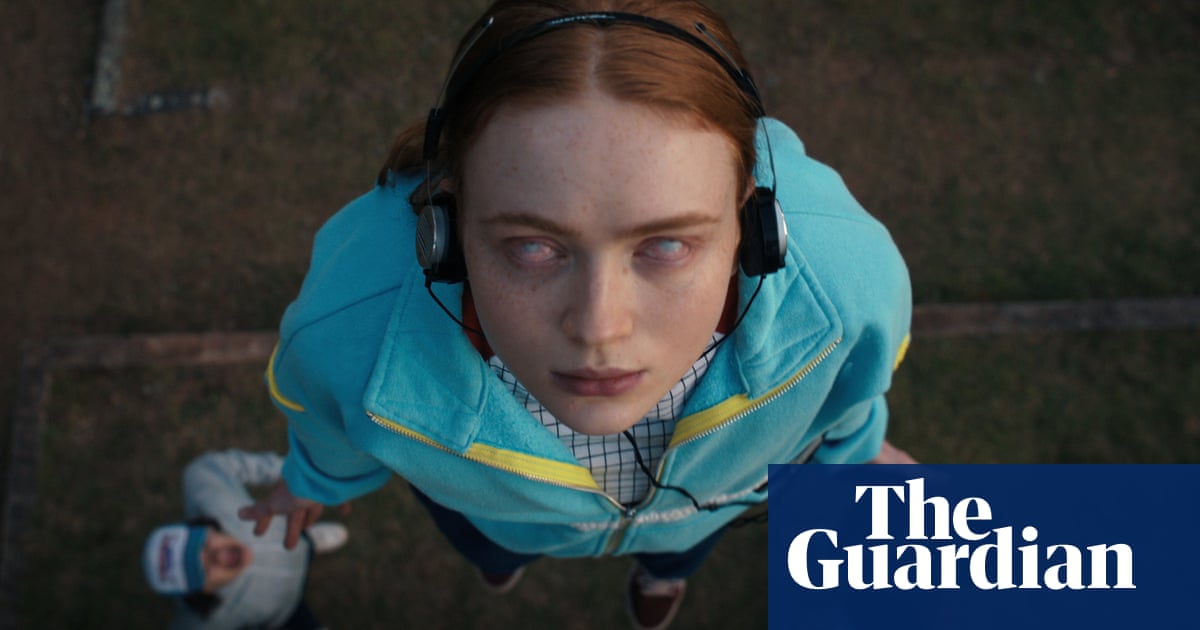
That syncing feeling: how Stranger Things supercharged the music industry
The impact of Running Up That Hill being used in Stranger Things was so great and so unprecedented that even Kate Bush was taken aback, calling it “quite shocking really” in a rare interview with BBC Radio 4’s Women’s Hour. The song’s placement in the gigantically popular Netflix show gave Bush her first UK No 1 in 44 years and first ever US Top 10 hit, 37 years after Running Up That Hill was first released.
“We’ll be hearing about it for the next 10 years at least, in terms of a reference point in marketing meetings,” says Jonathan Palmer of record label and music publisher BMG, about what will inevitably be called the Stranger Things effect.
Palmer is BMG’s senior vice president of creative synchronisation, music industry terminology for someone who looks after “syncs”, where a song – often a classic that is primed for rediscovery by a younger generation – is placed into a TV show, film, advert, video game or movie trailer. Think of how Nirvana’s Something In the Way was a cornerstone of The Batman earlier this year, or corny 70s soft rock dominated the Guardians of the Galaxy movies, and thanks to Stranger Things these syncs are becoming a bigger part of the music industry than ever.
Palmer cautions that Running Up That Hill is “a bit of a unicorn – most of my colleagues would admit that’s a once-in-a-decade thing,” but Bush is not a total outlier. Something similar is happening to Metallica’s Master of Puppets from 1986: since being used in Stranger Things’ finale earlier this month, it is currently climbing the Top 40 in the UK.
“It’s hard to predict how powerful a sync will be,” says Tim Miles, SVP of sync for UK and Europe at Warner Music Group, who distribute Bush’s music (she owns her own recorded and publishing rights). But, he says, “we did know it was going to be used a lot [in Stranger Things] and you could tell this was going to be a big moment.”
The proliferation of streaming platforms such as Netflix, Disney+ and Amazon Prime Video is unlocking enormous new opportunities for music sync, especially for catalogue titles such as Running Up That Hill. They are today’s priority platforms for sync teams and music supervisors for two reasons: enormous reach, and enormous budgets.
Connie Farr is founder of music supervision company ThinkSync and has worked on films and shows such as Rocks, After Love, Creation Stories and The Essex Serpent. She says that if a streaming platform is involved, music publishers and record labels will ask for exponentially greater fees to use songs in their catalogues.
“The likes of Amazon and Netflix made a lot of money during the pandemic and I feel like the dynamic has changed a little bit, with the rights holders going, ‘Right, you can afford to pay a proper fee for this,’” she says. “Even if the show has not been picked up by Netflix yet, the rights holders are still quoting with that in mind.”

Syncs’ power is twofold: they generate a fee for the music use and they also provide a promotional springboard for music that might have otherwise been overlooked. They have been used for decades – remember John Cusack holding up a boombox playing Peter Gabriel’s In Your Eyes in Say Anything? – but the difference today is that due to streaming, TV shows are immediately global instead of regional. “That’s unprecedented,” says Miles, “and that’s why we’re having this incredible effect with music when it’s used well.”
Record company marketing activity can be planned and coordinated around a major sync, as streaming services such as Spotify and Apple Music are lobbied to get behind a track. The new wildcard is TikTok: clips from shows can be decontextualised and chopped up into a variety of memes that may go viral, providing a powerful accelerant. This is something record companies cannot anticipate or manipulate.
“TV and film syncs are still pushing culture, but now people have got the ability to take that culture and go elsewhere with it,” explains Tom Gallacher, senior director of digital and marketing at Rhino UK, part of WMG. “If you look on TikTok, the #runningupthathill hashtag has got almost a billion views and there have been over two million creations using the sound.”
Particular musical eras are currently hot in TV shows, and Stranger Things, set in the 1980s, is both cause and symptom. “A lot of the scripts I get now are looking for music from the 1980s, reflecting the age of the directors,” says Farr, noting that when music is in vogue, the sync fees rise accordingly. “I know it’s going to be so expensive to clear.”
This trend is also partly reflected in the song catalogues being bought up by companies such as Hipgnosis, BMG, Universal Music Group, Sony Music Entertainment, WMG and Primary Wave. Artists such as Bob Dylan, Bruce Springsteen and various members of Fleetwood Mac have sold the rights to their songs to these companies for a cash lump sum in recent years, allowing the companies to accrue future revenue from them – and syncs are a major source of that revenue. These companies will be aggressively pitching the music they have acquired, heavily leaning towards the 1960s to the 1980s, to get the biggest and swiftest return on their investment.
These companies highlight the success of their sync departments when buying a catalogue, as proof that they can proactively land syncs (what are called procured syncs) rather than merely approving a sync request when it falls in their lap (a non-procured sync).
They also have to be careful that the catalogue of one act does not get reduced to one or two tracks. Sync teams are therefore actively working less obvious music one level down, what Palmer calls the “second-tier copyrights” in a catalogue. Farr says she sometimes gets a request for a specific track but then may offer an alternative that the show’s creators never thought of: for example, suggesting Little Simz’ Picture Perfect for Sarah Gavron drama Rocks instead of the much pricier and more obvious God’s Plan by Drake. “They’ll often go with the hidden gem because it’s unique,” she says. “I’m always trying to look for those catalogues, the ones that aren’t going to be astronomical.”

Occasionally music companies willingly license these lesser-known songs, perhaps for a reduced rate, because they see the wider promotional opportunities far outweighing one-off sync fees. “I definitely find that with the major labels,” says Farr. “If you show interest in something lesser known, they really will be cooperative in order to get it into something because it’s really helpful to them.”
Streamed TV allows catalogue tracks to find their way to younger viewers in ways that were inconceivable even a decade ago. “Summers used to be about going to the cinema and talking about the big movies that have come out, but streaming has changed that dynamic,” argues Miles. “Now we’re talking about the big TV shows. I feel it’s a lot more natural for a younger audience to hear a song on a TV show because it’s culturally relevant to them.”
An added bonus today is that an unexpectedly successful sync can be monetised instantly through streaming music services, sidestepping the historical lag in shipping product to record shops. This means that while streaming TV is now a huge catalyst for catalogue success, it is not the only one. Tracks will be constantly pitched to music streaming services’ own era- and genre-focused playlists while trends on TikTok are closely monitored so that when an old track suddenly takes off it can be capitalised on – the most obvious example being Dreams by Fleetwood Mac, which went viral in 2020.
The triple bonanza of a TV sync spiralling into music streaming services and TikTok is something that cannot be orchestrated though, only capitalised upon. For all the best laid plans of sync departments, it is often less about strategy and more about serendipity. “I’ve been doing this long enough,” says Palmer, “that I have resigned myself to not completely understanding where the alchemy is, how it works and how it really connects on a bigger level.”



































































